Last updated on
Explore the various reasons and benefits of placing a rug under your kitchen table in this comprehensive guide.
Picture this: a beautifully designed kitchen with sleek countertops, stylish cabinets, and a stunning dining table. But there’s something missing.
It feels incomplete, lacking that cozy touch that brings warmth and comfort to the space. That’s where the humble rug comes in.
You may be wondering if you really need a rug under your kitchen table. Well, let me tell you, it can make all the difference in transforming your dining area from ordinary to extraordinary.
In this article, we’ll explore why adding a rug under your kitchen table is not only aesthetically pleasing but also practical and functional. So let’s dive right in and discover the wonders of this simple yet impactful home decor accessory!
What's Inside
“The Purpose of a Rug Under Kitchen Table”

When it comes to home decor, every element serves a purpose. And the same goes for placing a rug under your kitchen table.
The purpose of this seemingly simple addition is multi-fold.
First and foremost, a rug under your kitchen table helps define the dining area within your kitchen space. It creates visual boundaries and separates the eating area from other parts of the room, such as cooking or prep areas.
This delineation can make your dining space feel more intimate and cozy.
Rugs provide practical benefits in terms of functionality and comfort. They act as a protective layer between your flooring and heavy furniture like chairs or tables, preventing scratches or damage caused by movement during meals.
Moreover, having a rug beneath your feet while sitting at the table adds an extra layer of cushioning that enhances overall comfort during mealtime gatherings with family or friends. No more discomfort from sitting on hard floors!
Lastly but certainly not least important – aesthetics! A well-chosen rug can tie together all elements in your kitchen’s design scheme effortlessly by adding texture, color coordination with other decor items (such as curtains), patterns that complement existing motifs (like tile backsplashes), or even introducing new design elements altogether.
“What to Consider Before Buying a Kitchen Rug”

After all, you want to make sure that the rug you choose not only enhances the overall aesthetic of your kitchen but also meets your practical needs.
First and foremost, think about the size of your dining area. Measure the space where you plan on placing the rug to ensure it fits perfectly without overwhelming or underwhelming the room.
A general rule of thumb is that there should be enough space around all sides of the table for chairs to comfortably slide in and out.
Next, consider what material would work best in a kitchen setting. Since kitchens tend to be high-traffic areas prone to spills and stains, opt for rugs made from durable materials such as polypropylene or nylon which are easy-to-clean and resistant against moisture.
Take into account any specific design preferences or color schemes within your kitchen decor. Do you want a bold statement piece that adds vibrancy? Or perhaps something more subtle that blends seamlessly with existing elements? Consider how different colors and patterns will complement or contrast with other aspects of your kitchen’s interior design.
Lastly, think about maintenance requirements. Some rugs may require frequent vacuuming while others can withstand occasional spot cleaning – choose one based on how much time and effort you’re willing to invest in upkeep.
“Choosing the Right Rug Size”
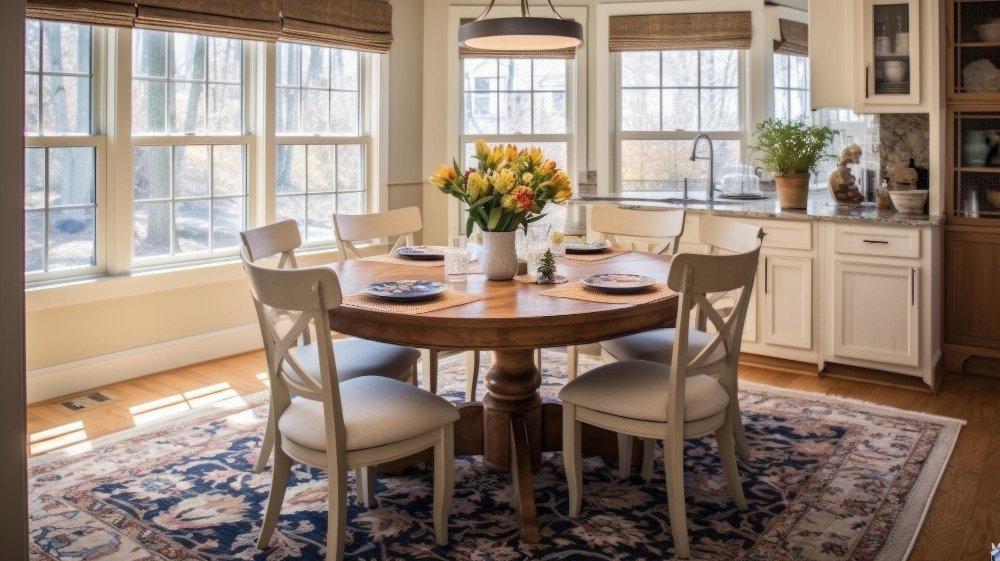
The size of your dining area and the dimensions of your table play a crucial role in determining the ideal rug size.
A well-proportioned rug can create visual harmony and define the space under your kitchen table. It should be large enough to accommodate not only the table but also all chairs when they are pulled out.
This ensures that everyone sitting at the table can comfortably rest their feet on soft, cushioned fibers.
To determine an appropriate rug size, start by measuring both length and width of your dining area. Allow for at least 24-30 inches beyond each side of the table so that chairs remain on top of it even when pulled out.
Keep in mind that rugs come in standard sizes such as 5×8 feet or 8×10 feet, but you may need a custom-sized one if you have an unusually shaped or oversized dining set.
“Picking the Right Rug Material”

Since the kitchen is a high-traffic area prone to spills and stains, durability and ease of cleaning should be at the top of your list.
One popular option for kitchen rugs is synthetic materials such as nylon or polyester. These materials are known for their stain resistance and easy maintenance.
They can handle frequent foot traffic without showing signs of wear and tear too quickly. They often come in a wide range of colors and patterns, allowing you to find one that complements your kitchen decor perfectly.
If you prefer natural fibers, wool rugs are an excellent choice for kitchens due to their resilience against stains and dirt. Wool has natural water-repellent properties which make it easier to clean up spills before they seep into the fibers.
Another consideration when selecting rug material is its ability to withstand moisture in the kitchen environment. Cotton rugs may not be ideal as they tend to absorb liquids easily which can lead them becoming stained or developing mildew over time.
“Durable Rug Materials for the Kitchen”

The kitchen is undoubtedly one of the busiest areas in any home, with spills, foot traffic, and potential stains being a common occurrence. Therefore, selecting a rug made from durable materials becomes essential.
One popular option for kitchen rugs is polypropylene. This synthetic material offers excellent stain resistance and can withstand heavy use without showing signs of wear and tear.
It’s also easy to clean – simply wipe away spills or give it a quick spot cleaning if needed.
Another durable choice is nylon. Known for its strength and resilience, nylon rugs are highly resistant to crushing or matting under furniture legs or constant foot traffic in the kitchen area.
If you prefer natural fibers like cotton or wool but still want durability in your kitchen rug, consider opting for blends that incorporate these materials with synthetic fibers such as polyester or acrylic. These blends offer the best of both worlds – the softness and comfort of natural fibers combined with added strength from synthetics.
Remember that when selecting a durable rug material for your kitchen table area specifically (where chairs may be constantly pulled out), look out for options that have low pile heights as they are less likely to get caught under chair legs compared to high-pile rugs which can cause tripping hazards.
By choosing resilient materials like polypropylene, nylon blends, or low-pile options incorporating natural fibers blended with synthetics, you’ll ensure that your chosen rug stands up well against daily wear and tear while maintaining its visual appeal over time.
“Navigating Rug Placement Under Kitchen Table”

Finding the perfect spot for your rug can greatly enhance both the visual appeal and functionality of your dining area.
Consider starting by measuring your dining table and chairs. Ideally, you’ll want a rug that extends beyond all sides of the table when chairs are pulled out.
This ensures that even when guests are seated, their chair legs remain on the soft surface rather than scratching or damaging your flooring.
Another important factor to consider is traffic flow. You don’t want anyone tripping over an ill-placed rug while moving around in a busy kitchen environment.
Make sure there’s enough space between walls and other furniture so that people can comfortably walk around without any obstructions.
Take into account any existing features in your kitchen such as floor vents or electrical outlets which may affect where you can place a large-sized rug.
Lastly, think about how much visible floor space you’d like to leave uncovered by rugs. If you have beautiful hardwood floors or tiles that deserve some attention too, consider opting for smaller rugs strategically placed only under certain areas of the table instead of covering up everything completely.
“Rug Shapes: Which Works Best Under Kitchen Table?”
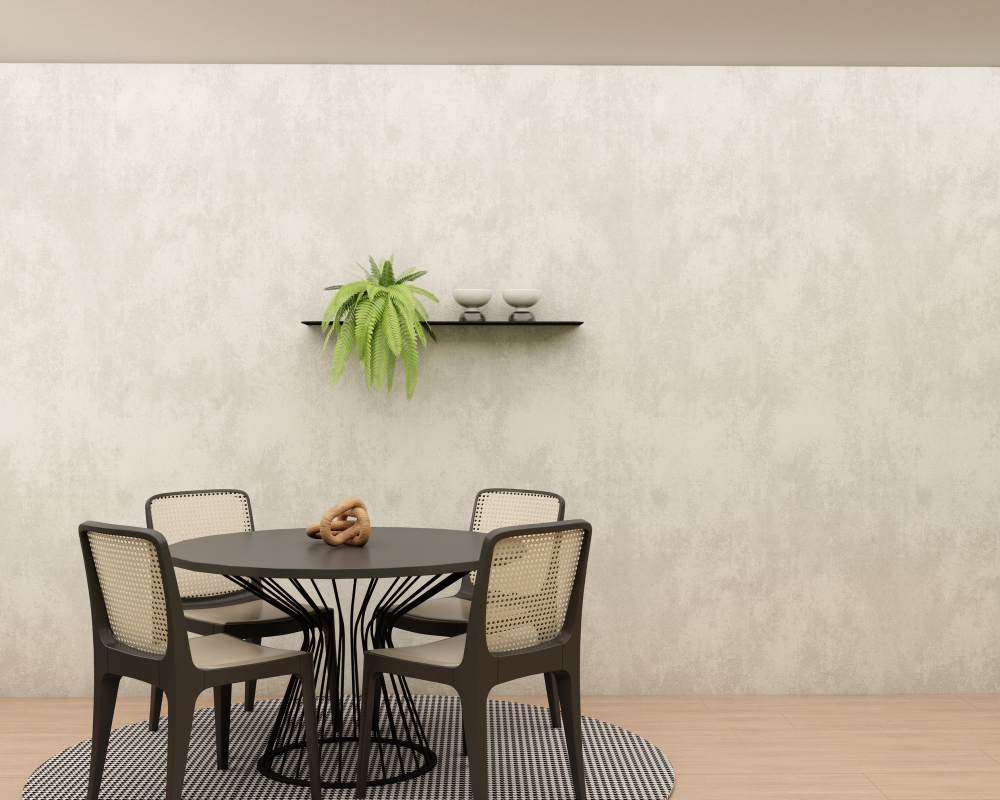
Different rug shapes can create different visual effects and impact how well it fits within the space.
Rectangular rugs are one of the most popular choices for placing under a kitchen table. They provide clean lines that align with rectangular or oval-shaped tables, creating symmetry and balance in your dining area.
Rectangular rugs also offer ample coverage, ensuring that all chairs around the table have enough space on which to sit comfortably.
If you have a round or square kitchen table, consider opting for a circular or square-shaped rug respectively. These shapes complement their corresponding tables perfectly by mirroring their contours and creating harmony within your decor scheme.
For those who prefer something more unique, an irregularly shaped rug can add an interesting focal point to your kitchen’s design. Irregularly shaped rugs come in various forms such as abstract patterns or organic silhouettes that break away from traditional geometric shapes while still providing functional coverage beneath your dining set.
Ultimately, when selecting a shape for your kitchen rug under the table, consider both practicality and personal preference. Take into account factors like room size, furniture placement around the table (such as nearby cabinets), traffic flow patterns within this space before making any final decisions about what will work best aesthetically speaking!
“A Step By Step Guide to Positioning Your Kitchen Rug”
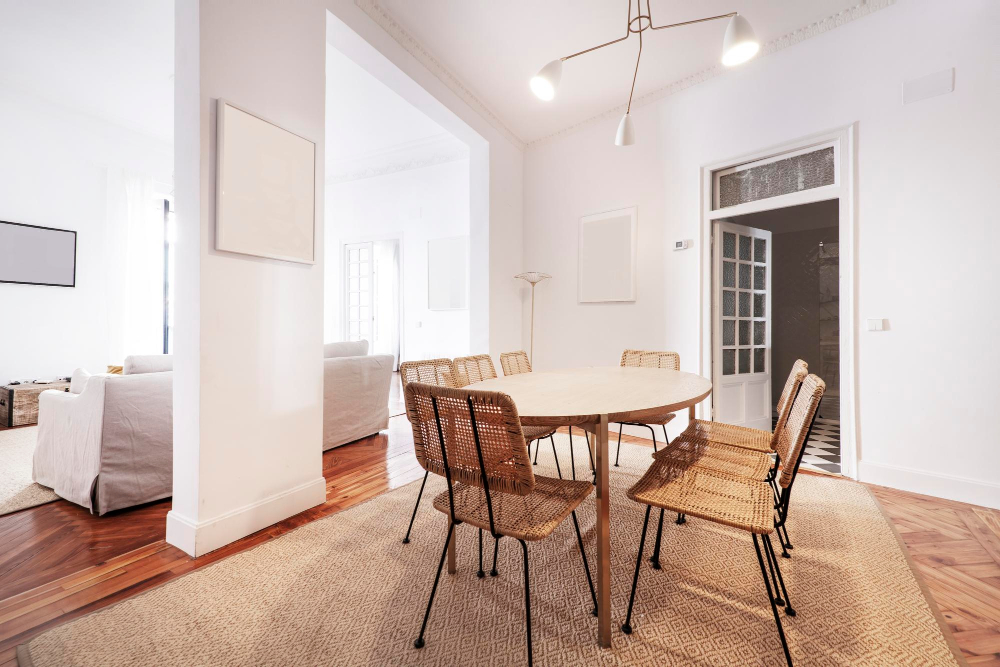
Follow these simple steps to ensure you get it just right:
1. Measure Your Table: Start by measuring the dimensions of your kitchen table.
This will help determine the appropriate size for your rug.
2. Consider Rug Shape: Take into account both the shape of your table and the available space in your kitchen when selecting a rug shape.
Round tables often pair well with round or square rugs, while rectangular tables work best with rectangular or oval rugs.
3. Allow for Chair Movement: Make sure there is enough room around each chair so they can be comfortably pulled out without catching on the edge of the rug.
4.
“Ensuring Rug Safety in the Kitchen”
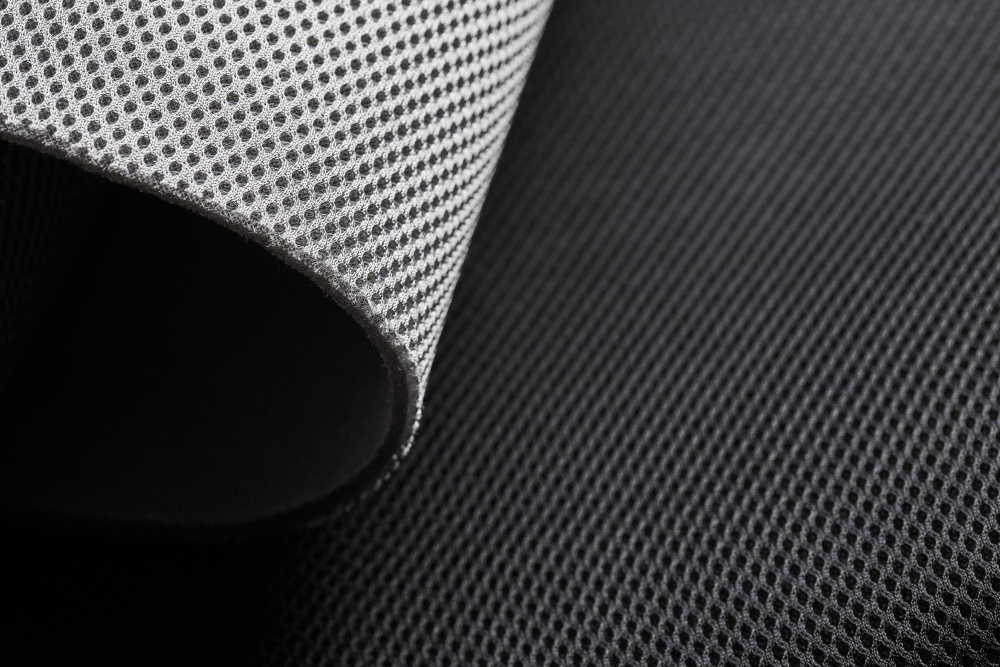
After all, the last thing you want is for someone to trip or slip while enjoying a meal with family and friends. So how can you ensure that your rug stays securely in place? Let’s explore some essential tips for maintaining rug safety in the kitchen.
Firstly, consider using a non-slip rug pad underneath your kitchen rug. These pads provide an extra layer of grip between the floor and the underside of the carpet, preventing any unwanted movement or sliding.
They are particularly useful if you have hardwood or tile flooring which tends to be more slippery.
Make sure that your chosen rug size is appropriate for your dining area. A too-small carpet may easily bunch up or slide around when chairs are moved back and forth during meals.
On the other hand, an oversized carpet might create tripping hazards as its edges extend beyond furniture legs.
Regular maintenance plays another crucial role in ensuring both cleanliness and safety within this high-traffic area of your home. Vacuuming regularly will help remove any loose debris from both on top of and beneath the surface of rugs—preventing potential slips caused by small particles caught underfoot.
Lastly but importantly: spills happen! Inevitably there will come a time when food or drink finds its way onto our beloved rugs during mealtime mishaps (especially if children are involved). Promptly clean up any spills on rugs to prevent staining as well as slipping hazards due to wet surfaces.
“Colored Vs Neutral: Choosing the Right Rug Color”

The decision between these two can greatly impact the overall look and feel of your dining area.
Colored rugs can add a vibrant pop of personality to your kitchen. They come in a wide range of hues, from bold reds and blues to soft pastels and earthy tones.
If you want to make a statement or create visual interest in an otherwise monochromatic space, opting for a colored rug is an excellent choice. It can inject energy into the room and become a focal point that ties together different elements of your decor.
On the other hand, neutral rugs offer versatility and timelessness. Shades like beige, gray, ivory, or taupe blend seamlessly with any existing color scheme in your kitchen.
They provide a subtle backdrop that allows other design elements such as furniture or artwork to take center stage without overwhelming them visually.
The decision between colored and neutral rugs ultimately depends on personal preference as well as the overall aesthetic you wish to achieve in your kitchen space. Consider factors such as wall colors, cabinetry finishes, lighting conditions (natural vs artificial), size of the room before making this choice.
“Complementing Your Kitchen Decor With a Rug”
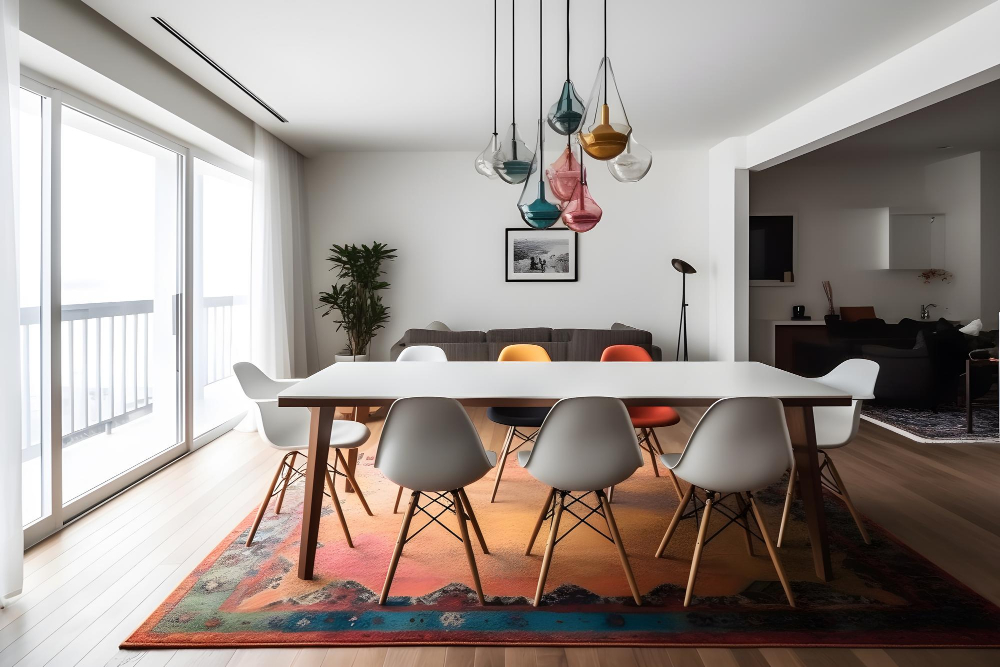
Your kitchen rug is no exception. It has the power to tie your entire kitchen decor together and elevate the overall aesthetic.
To complement your kitchen decor with a rug, consider the existing color palette in your space. If you have neutral tones dominating your kitchen, adding a pop of color through a vibrant rug can instantly breathe life into the room.
On the other hand, if you already have bold colors or patterns in play, opting for a more subtle or monochromatic rug can help balance out the visual impact.
Another aspect to consider is style cohesion. If you have an eclectic or bohemian-inspired kitchen design, don’t be afraid to experiment with patterned rugs that feature intricate designs and vibrant hues.
For minimalist or modern kitchens with clean lines and sleek finishes, opt for rugs that are simple yet elegant in their design.
Texture also plays an important role in complementing your overall decor theme. Consider incorporating different textures through materials like jute or sisal for natural warmth and rustic charm; plush wool for added coziness; or even synthetic fibers like nylon for easy maintenance in high-traffic areas.
Lastly, don’t forget about size! Ensure that your chosen rug fits proportionally within its designated area under the table without overwhelming it visually.
“Exploring Different Rug Styles for Your Kitchen”
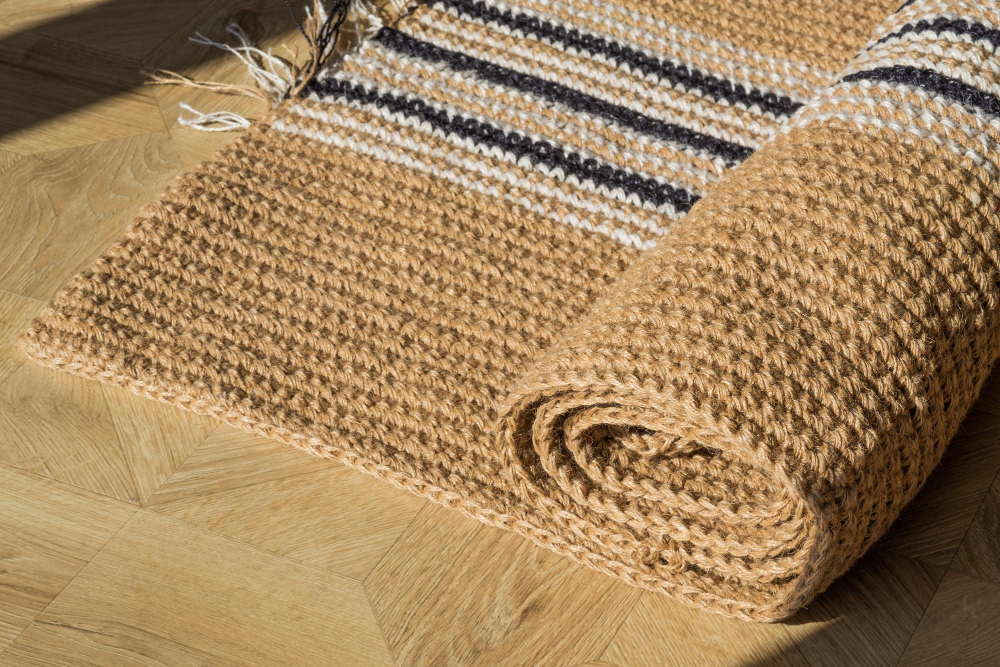
The right rug can enhance the overall aesthetic of your space and tie together different design elements seamlessly. Let’s explore some popular rug styles that work well in kitchens.
1. Traditional Rugs: If you have a classic or vintage-inspired kitchen, traditional rugs with intricate patterns and rich colors can add an elegant touch to the space.
2. Modern/Contemporary Rugs: For those with sleek and minimalist kitchens, modern or contemporary rugs featuring clean lines and bold geometric patterns can create a visually striking focal point.
3. Natural Fiber Rugs: If you prefer an organic look, consider natural fiber rugs like jute or sisal.
These earthy textures bring warmth while adding a rustic charm to your kitchen decor.
4. Moroccan/Tribal Rugs: Adding an exotic flair to any kitchen, Moroccan or tribal-style rugs feature vibrant colors and unique geometric designs that make them stand out as statement pieces in both traditional and modern settings.
5.Vintage/Oriental Rugs: Vintage or oriental-style rugs exude timeless elegance with their intricate motifs and rich color palettes.They effortlessly blend into various design themes while adding character to your kitchen area.
“Maintenance and Cleaning Tips for Kitchen Rugs”

After all, the kitchen is a high-traffic area prone to spills and stains. But fear not! With a few simple tips, you can keep your kitchen rug looking fresh and vibrant for years to come.
Regular vacuuming is key when it comes to maintaining your kitchen rug. Food crumbs, dirt, and debris can easily accumulate on its surface over time.
By vacuuming at least once a week or more frequently if needed, you’ll prevent these particles from embedding themselves into the fibers of the rug.
In addition to regular vacuuming, spot cleaning should be done promptly whenever spills occur. Blotting up liquid spills with a clean cloth or paper towel as soon as possible will help prevent staining.
For solid substances like food or grease stains that may have made their way onto your beloved rug during meal prep mishaps (we’ve all been there!), gently scrape off any excess material before treating with an appropriate stain remover.
When choosing cleaning products for your kitchen rugs, always check manufacturer guidelines first as different materials may require specific care instructions. Some rugs are machine washable while others may need professional cleaning services due to delicate fabrics or intricate designs.
For machine-washable rugs in particular:
- Check if they fit within recommended size limits for washing machines.
- Use mild detergent specifically formulated for delicate fabrics.
- Wash on gentle cycle using cold water.
- Avoid using bleach unless specified by manufacturer instructions.
- Air-dry flat rather than tumble drying in order to preserve shape and avoid shrinkage.
“Health Factors: Are Kitchen Rugs Allergens?”
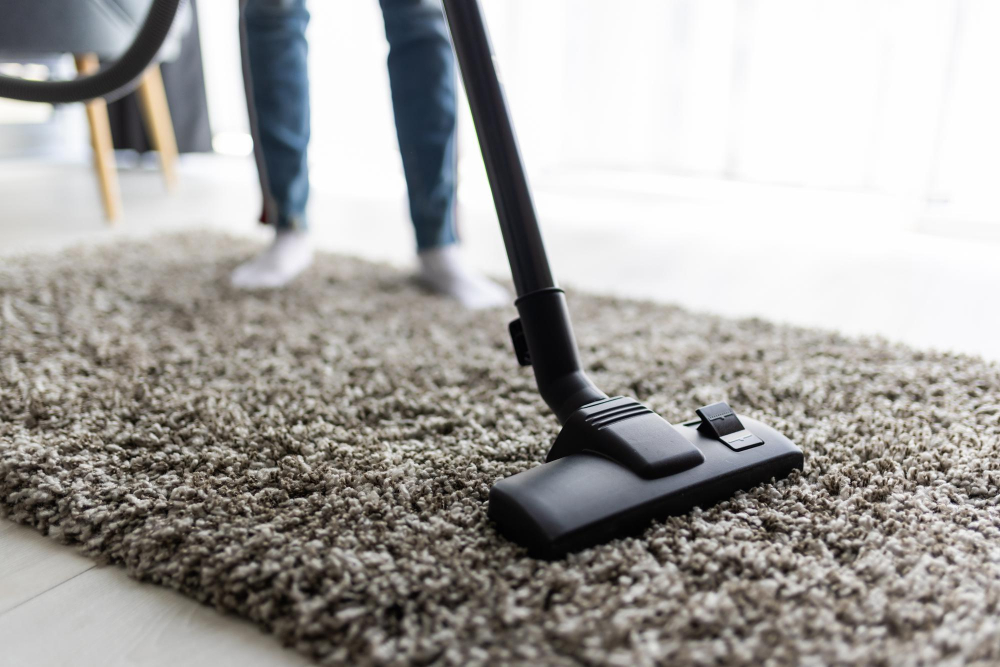
This brings us to an important consideration when deciding whether or not to place a rug under your kitchen table: allergens.
Kitchen rugs can potentially harbor allergens such as dust mites, pet dander, pollen, and food particles. These microscopic irritants can trigger allergies or respiratory issues in sensitive individuals.
However, with proper care and maintenance, you can minimize the risk of allergen buildup in your kitchen rug.
Regular vacuuming is key in keeping your rug clean from dust mites and other airborne particles that may settle on its surface. Opt for a vacuum cleaner with a HEPA filter which effectively traps even the tiniest allergens.
Choosing synthetic materials like nylon or polyester for your kitchen rug can be beneficial as they are less likely to attract dust mites compared to natural fibers like wool or cotton. Synthetic rugs are also easier to clean thoroughly.
If you have severe allergies or asthma concerns within your household but still desire the aesthetic appeal of a rug under your kitchen table, consider using washable rugs made specifically for kitchens. These types of rugs often have anti-allergenic properties built into their design making them more resistant against common triggers.
“Rug Padding: Necessary or Optional?”
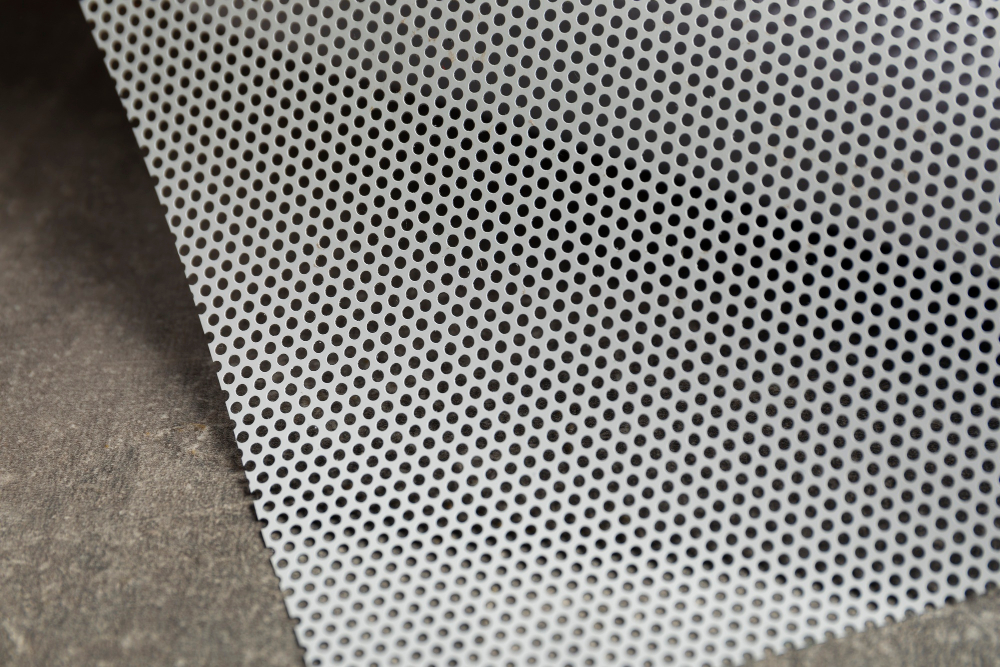
Well, let’s shed some light on this topic.
Rug padding serves as a protective layer between the floor and the rug itself. It not only provides cushioning but also helps keep the rug in place, preventing slips and slides during mealtime gatherings or when kids are running around.
While some might argue that adding padding is unnecessary in areas with low foot traffic like kitchens, it still offers several benefits worth considering. Firstly, it adds an extra layer of comfort underfoot while dining or standing for longer periods in the kitchen.
This can be especially beneficial if you have hardwood floors that tend to feel hard after extended use.
Secondly, using a pad can help extend the lifespan of your rugs by reducing wear and tear caused by friction against hard surfaces over time. The added cushioning absorbs impact and reduces stress on both your flooring and rugs themselves.
Lastly, having proper padding underneath prevents slippage accidents which could lead to injuries – something we definitely want to avoid!
That being said, whether you choose to include rug padding ultimately depends on personal preference and specific circumstances within your kitchen area. If stability is already ensured due to carpeted floors or heavy furniture holding down corners of larger rugs effectively enough for safety purposes without additional support from pads – then opting out might be reasonable here too!
While not absolutely essential for every situation, rug paddings offer increased comfort, prolonged durability, and enhanced safety.
“Alternatives to Placing Rugs Under Kitchen Table”
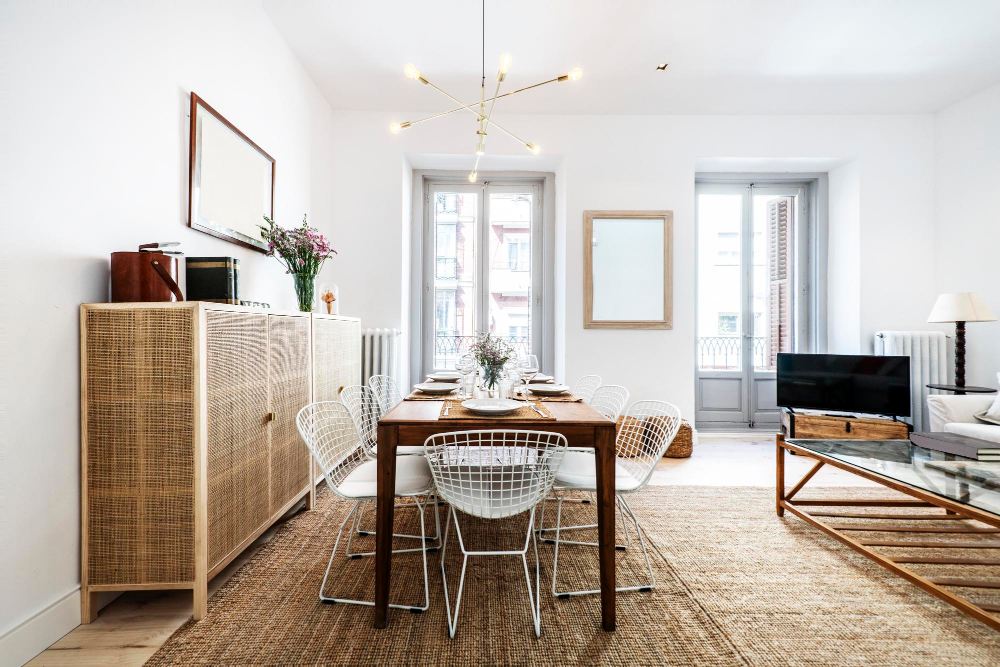
If you prefer an alternative approach or have specific reasons for not wanting a rug, there are still ways to achieve a stylish and functional space.
One alternative is opting for a larger dining room carpet that covers both the table and surrounding seating area. This creates cohesion in the space while providing comfort underfoot without needing multiple rugs.
Another option is using floor tiles or vinyl flooring with patterns or designs specifically placed beneath your kitchen table. This allows you to create visual interest without relying on traditional rugs.
For those who prefer minimalism, leaving bare floors underneath the kitchen table can also be an appealing choice. This works particularly well if you have beautiful hardwood floors or unique tile patterns that you want to showcase as part of your overall design aesthetic.
Incorporating other elements such as chair cushions with vibrant colors or interesting textures can add visual appeal and provide some cushioning without requiring a rug underneath.
Ultimately, whether you choose to go with a traditional rug placement or explore alternatives depends on personal preference and style preferences.
“Where to Buy Kitchen Rugs: Offline Vs Online”

Both avenues offer their own advantages and considerations.
Offline shopping allows you to physically see and feel the rugs before making a purchase. You can visit local home decor stores, furniture outlets, or even specialty rug shops.
This hands-on experience gives you the opportunity to assess the quality of materials, check colors in person, and get an accurate sense of size.
On the other hand, online shopping provides convenience and a vast array of choices at your fingertips. With just a few clicks from the comfort of your own home (or kitchen!), you can browse through countless designs from various retailers around the world.
Online platforms often provide detailed product descriptions along with customer reviews that can help guide your decision-making process.
Whether you choose offline or online shopping ultimately depends on personal preference and circumstances such as time availability and access to physical stores in your area. Some people enjoy exploring different shops in person while others prefer browsing through virtual catalogs without leaving their homes.
Regardless of which option suits you best, it’s important to do thorough research beforehand by reading customer reviews if available (both positive and negative) as well as checking return policies for any potential issues that may arise after purchase.
“Solving Common Issues With Kitchen Rugs”
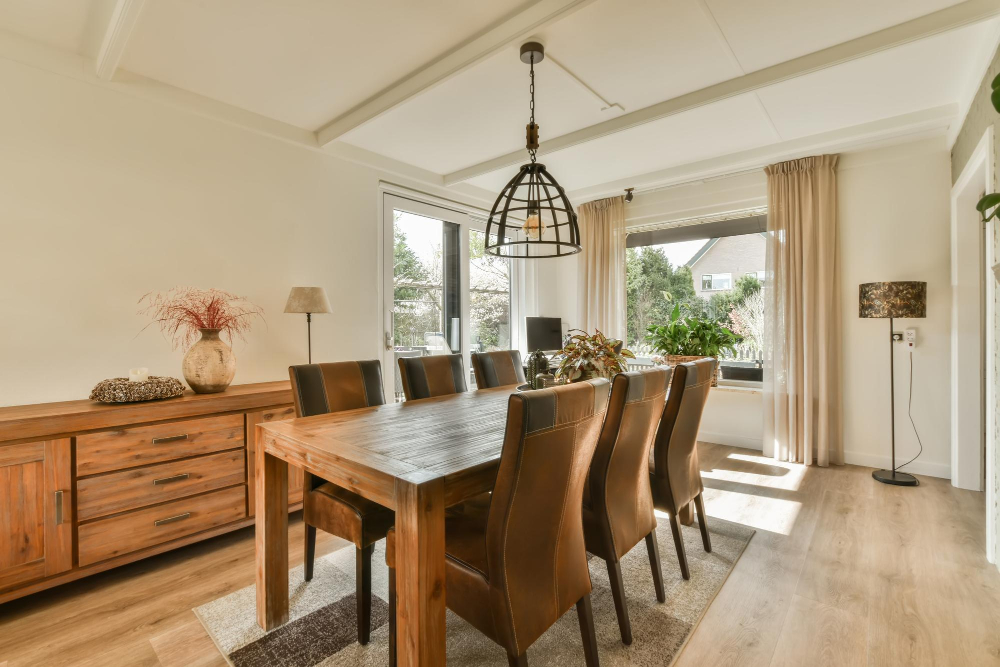
Don’t worry though, because we’ve got you covered with solutions to these challenges.
One common issue is the rug sliding or bunching up when chairs are moved in and out during meals. To prevent this, consider using a non-slip rug pad underneath the rug.
This will provide grip and stability, keeping the rug securely in place.
Another concern is spills and stains from food or drinks that inevitably occur in a kitchen setting. Opt for rugs made from stain-resistant materials such as polypropylene or nylon which are easy to clean and maintain.
Treating your rugs with fabric protectors can help repel liquids and make cleaning even easier.
If you have pets who tend to shed fur around the dining area, choose rugs with shorter pile heights as they are less likely to trap pet hair compared to longer shaggy rugs.
Uneven floors can also pose an issue when placing a flat surface like a dining table on top of them. In such cases, use furniture pads under each leg of the table for balance so that it doesn’t wobble or cause any instability on top of the rug.
Lastly but importantly – safety! Ensure that there are no tripping hazards caused by raised edges or corners of your chosen kitchen rug design. Opt for low-profile options if this is something you’re concerned about.
“Impacts of a Rug On Kitchen Sound Absorption”
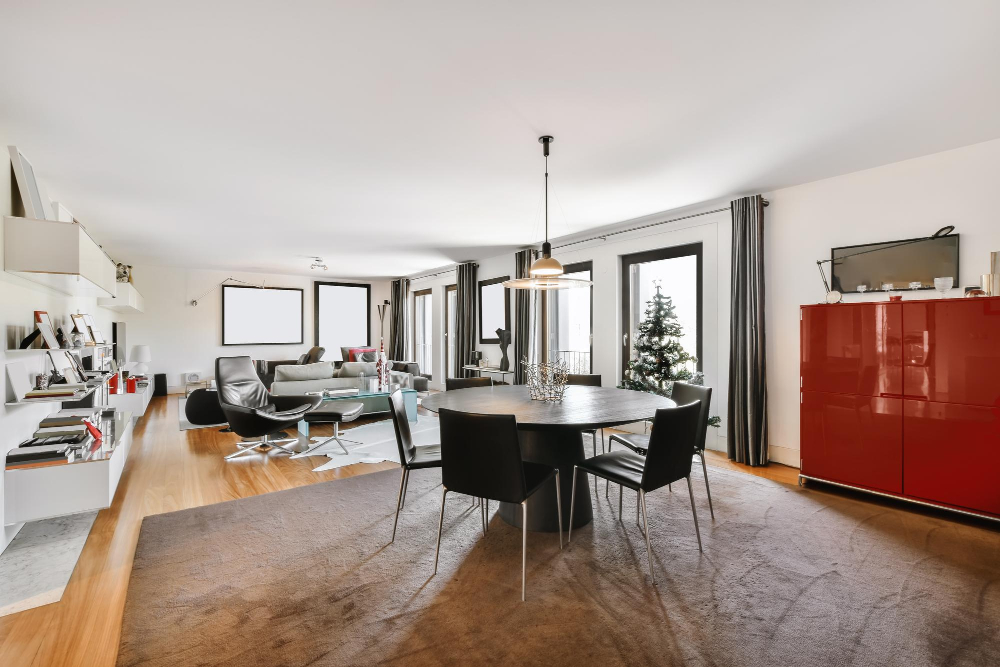
You may not realize it, but the acoustics in your kitchen can greatly affect the overall ambiance and comfort of the space.
Think about those moments when you’re enjoying a meal with family or friends. The clinking of cutlery, conversations bouncing off hard surfaces – all these sounds can create a cacophony that detracts from the dining experience.
This is where a well-chosen rug comes to play its part.
By adding a rug under your kitchen table, you introduce an element that helps absorb and dampen sound waves within the room. The soft fibers act as natural barriers to noise transmission, reducing echoes and reverberations caused by hard flooring materials like tile or hardwood.
Not only does this enhance conversation clarity during meals but it also creates an overall more pleasant atmosphere for everyone present in your kitchen-dining area. Whether you’re hosting dinner parties or simply enjoying everyday meals with loved ones, having better control over noise levels adds to both comfort and enjoyment.
FAQ
Do you have to put a rug under kitchen table?
A rug under the kitchen table is not necessary but highly beneficial for wood floors to prevent scratches and spills, although felt pads can also serve this purpose.
What is the purpose of a rug under a dining table?
The purpose of a rug under a dining table is to dampen sound, protect floors from shuffling feet and sliding chairs, and warm up the room, thus serving as an essential element for busy, entertainment-focused spaces like the dining room.
Do people put rugs in kitchens?
Yes, people do put rugs in kitchens as they are an ingenious way to energize the space.
What is the best type of rug to put under a kitchen table?
The best type of rug to put under a kitchen table is a low-pile or flat weave rug.
What are the considerations when choosing a rug for under the kitchen table?
The considerations when choosing a rug for under the kitchen table include the rug’s material for easy cleaning, size to fit the table and chairs, durability for high traffic, non-slip backing for safety, and a design that matches the kitchen decor.
What are the potential downsides of having a rug in the kitchen area?
The potential downsides of having a rug in the kitchen area may include it acting as a breeding ground for bacteria and germs due to food spills, stains and soaking up moisture.
How often should you clean a kitchen rug placed under the dining table?
Experts recommend cleaning a kitchen rug placed under the dining table once a week.





